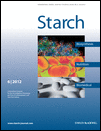
STARCH-STARKE
Scope & Guideline
Driving Excellence in Food Science and Chemistry
Introduction
Aims and Scopes
- Starch Characterization and Properties:
Research on the physicochemical, thermal, and rheological properties of starch from various sources, including native and modified starches, to understand their behavior in different applications. - Starch Modification Techniques:
Studies focused on various physical and chemical modification methods to enhance the functional properties of starch, such as gelatinization, retrogradation, and digestibility. - Applications of Starch in Food Science:
Investigations into the use of starch in food formulations, including its role in texture, stability, and nutritional aspects, particularly in relation to resistant starch and dietary fibers. - Biodegradable and Sustainable Materials:
Research on developing starch-based biopolymers and composites for sustainable applications, including biodegradable films and packaging materials. - Nanotechnology in Starch Research:
Exploration of starch nanostructures and their applications in drug delivery systems, food preservation, and as functional additives. - Health Implications of Starch Consumption:
Studies examining the impact of different types of starch on health, including their effects on glycemic indices, digestive health, and potential as functional foods.
Trending and Emerging
- Sustainable and Biodegradable Starch Applications:
A growing emphasis on developing starch-based materials that are environmentally friendly and biodegradable, especially in packaging and film applications. - Health Benefits and Functional Foods:
Increasing research on the health implications of resistant starch and its role as a functional food ingredient, particularly in managing diabetes and promoting gut health. - Advanced Modification Techniques:
Emerging interest in novel modification techniques, including enzymatic, ultrasonic, and microwave-assisted methods, to enhance the properties and functionalities of starch. - Starch Nanotechnology:
A noticeable trend towards investigating starch nanoparticles and their applications in drug delivery, food preservation, and as smart materials. - Cross-Disciplinary Applications of Starch:
Research is expanding into interdisciplinary applications of starch, including in biomedical fields, such as drug delivery systems and wound dressings, reflecting its versatility beyond traditional uses.
Declining or Waning
- Traditional Starch Sources:
Research on conventional starch sources, such as potato and corn, appears to be waning as interest shifts toward underutilized and novel starch sources that offer unique properties and functionalities. - Basic Starch Chemistry:
Studies that focus solely on the fundamental chemistry of starch without application contexts are becoming less frequent, as the journal emphasizes more applied research. - Starch in Non-Food Applications:
The exploration of starch applications outside the food industry, such as in industrial processes or non-biodegradable materials, has seen a decrease, with a stronger focus on sustainable and biodegradable alternatives.
Similar Journals
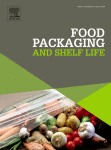
Food Packaging and Shelf Life
Exploring the intersection of materials science and food quality.Food Packaging and Shelf Life is an esteemed peer-reviewed journal published by Elsevier, dedicated to advancing the field of food science through innovative research on packaging materials and their impact on food preservation. With an impressive impact factor and ranking within the Q1 quartile across several categories—including Biomaterials, Food Science, and Microbiology (medical) provided in Scopus raking—this journal serves as a vital resource for researchers, academics, and industry professionals aiming to enhance food safety and quality. Established in 2014, it encompasses a multidisciplinary approach that integrates engineering, microbiology, and materials science perspectives to address current challenges in food packaging. Although currently not an open-access journal, it offers various subscription options, ensuring accessibility to cutting-edge research. As the sector rapidly evolves, Food Packaging and Shelf Life remains a critical platform for disseminating knowledge and fostering collaboration in the pursuit of sustainable food systems.

Carbohydrate Polymers
Pioneering breakthroughs in carbohydrate applications.Carbohydrate Polymers is a prestigious academic journal, published by ELSEVIER SCI LTD, that plays a vital role in the field of materials chemistry, organic chemistry, and polymer science. With its Q1 category rankings in these domains, this journal serves as a critical platform for disseminating high-quality research, innovative methodologies, and significant advancements in carbohydrate-based polymers. Since its inception in 1981 and continuing until 2025, it has fostered critical discussions and collaborations among researchers, professionals, and students worldwide. Although it does not offer open access, its rigorous peer-review process ensures that only the most impactful studies are published. By highlighting new developments in the synthesis, characterization, and application of carbohydrate polymers, Carbohydrate Polymers consistently contributes to the enhancement of knowledge and technology within its field, making it an essential resource for anyone working at the intersection of chemistry and materials science.

JOURNAL OF FOOD SCIENCE AND TECHNOLOGY-MYSORE
Driving Progress in Food Science for a Healthier WorldJOURNAL OF FOOD SCIENCE AND TECHNOLOGY-MYSORE, published by SPRINGER INDIA, is a distinguished peer-reviewed journal that has been contributing to the ever-evolving field of food science since its inception in 1974. With an ISSN of 0022-1155 and E-ISSN 0975-8402, this journal holds a commendable position in the Q2 category for Food Science, as per the 2023 metrics, and ranks #58 out of 389 in Scopus's Agricultural and Biological Sciences sector, achieving an impressive 85th percentile. The journal publishes high-quality research articles, reviews, and case studies that cover a wide array of topics, from food preservation to innovative technologies in food processing. Although it is not an open-access journal, it endeavors to disseminate essential knowledge and research strategies that advance food science and benefit both industry professionals and academia. The geographical reach of the journal, alongside its rigorous editorial standards, solidifies its stature as a pivotal resource for researchers, professionals, and students dedicated to the enhancement of food science practices and technologies.

International Food Research Journal
Nurturing Interdisciplinary Dialogue in Food StudiesThe International Food Research Journal, published by UNIV PUTRA MALAYSIA PRESS, serves as a pivotal platform for disseminating innovative research within the field of food science. With an ISSN of 1985-4668 and an E-ISSN of 2231-7546, the journal has successfully established its presence since its inception in 2007, converging its findings through 2024. This esteemed journal holds a Q3 ranking in Food Science, illustrating its valuable contributions to the field as demonstrated by its Scopus rank of 276 out of 389, placing it in the 29th percentile among its peers in Agricultural and Biological Sciences. Although it operates under a traditional publishing model, its academic integrity and focus on high-quality research ensure that it remains a vital resource for researchers, professionals, and students eager to explore advances in food technology, nutrition, and safety. By encouraging interdisciplinary collaboration and critical dialogue, the International Food Research Journal plays an essential role in shaping the future of food science research.
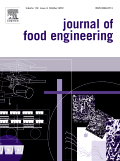
JOURNAL OF FOOD ENGINEERING
Advancing food science through engineering innovation.JOURNAL OF FOOD ENGINEERING, published by ELSEVIER SCI LTD, stands as a leading platform for innovative research within the realm of food science, focusing on the engineering principles applied to food production and processing. With an impressive impact factor reflective of its significance in the field, the journal boasts a Q1 ranking in Food Science and ranks #23 out of 389 in Agricultural and Biological Sciences according to Scopus metrics, placing it in the 94th percentile among its peers. Since its inception in 1982, the journal has aimed to disseminate high-quality, peer-reviewed research that informs and shapes industry practices and academic explorations. Although it does not currently offer an open access option, the journal is dedicated to fostering knowledge and innovation through rigorous editorial standards and a commitment to covering a broad range of topics related to food engineering. Researchers, professionals, and students alike will find the journal an invaluable resource for advancing their understanding of the scientific and technological facets of food systems.

ACS Food Science & Technology
Unveiling the Science Behind Every BiteACS Food Science & Technology is a premier peer-reviewed journal published by the American Chemical Society (ACS) that addresses the dynamic intersections of food science, chemistry, and technology. With its E-ISSN: 2692-1944, this journal aims to disseminate innovative research and comprehensive reviews that enhance understanding in fields such as analytical chemistry, organic chemistry, and general food science. Despite the absence of an Open Access model, its position in the Q2 quartile for multiple categories in 2023 underscores its significant impact on the scholarly landscape, ensuring researchers can access high-quality research pertinent to today's food challenges. With an expanding timeline of 2021 to 2024, ACS Food Science & Technology is poised to be an essential resource for advancing the scientific community's knowledge, fostering collaboration, and bridging gaps between academia and industry.
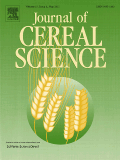
Journal of Cereal Science
Innovating food science with every publication.The Journal of Cereal Science, published by ACADEMIC PRESS LTD- ELSEVIER SCIENCE LTD, stands as a pivotal platform for the dissemination of high-quality research in the fields of biochemistry and food science, maintaining an impressive impact factor that reflects its influential position in academia. With a Q1 ranking in Food Science and a Q2 in Biochemistry as of 2023, the journal is recognized for its rigorous peer-review process and its commitment to advancing the understanding of cereal grains and their applications. Since its inception in 1983, the journal has provided comprehensive insights into areas such as grain genetics, processing technology, and nutritional aspects of cereals, catering to an audience of researchers, professionals, and students alike. The scope encompasses a diverse range of topics, ensuring a broad interdisciplinary appeal. Published through the prestigious Elsevier platform, it fosters global collaboration and knowledge sharing, thereby playing a crucial role in shaping the future of cereal science.

INTERNATIONAL JOURNAL OF POLYMER ANALYSIS AND CHARACTERIZATION
Illuminating the complexities of polymeric materials.International Journal of Polymer Analysis and Characterization is a distinguished scholarly publication dedicated to the field of polymer science, with a focus on innovative methodologies and significant advances in the analysis and characterization of polymeric materials. Published by Taylor & Francis Ltd in the United Kingdom, this journal serves as a vital resource for researchers, professionals, and students deeply engaged in Analytical Chemistry, Chemical Engineering, and Polymer Science. With a convergence spanning from 1995 to 2024, it holds a Q3 ranking in the 2023 category quartiles for its valuable contributions to the fields of Analytical Chemistry, Chemical Engineering, and Polymers and Plastics. Despite being a non-open access publication, its rigorous peer-review process and comprehensive coverage of current trends ensure that the journal remains a crucial platform for disseminating impactful research. The journal is indexed in various databases, underscoring its relevance and quality in the academic community. Exploratory studies and articles that push the boundaries of polymer analysis find a welcoming home within these pages, making it an essential read for those aiming to stay at the forefront of polymer research.

JOURNAL OF POLYMERS AND THE ENVIRONMENT
Leading the Charge in Polymer Impact StudiesJOURNAL OF POLYMERS AND THE ENVIRONMENT, published by Springer, is a leading academic journal in the fields of environmental engineering and materials chemistry, providing a vital platform for researchers, professionals, and students engaged in the study of polymers and their environmental impacts. With an impressive impact factor, the journal has established itself as a crucial resource in both the Q1 and Q2 quartiles for its respective categories, demonstrating its high-quality contributions to the scientific community. The journal, with ISSN 1566-2543 and E-ISSN 1572-8919, has been active since 2000 and continues to evolve as it converges towards 2024, ensuring it stays at the forefront of innovative research. Researchers will find the journal’s comprehensive analysis of polymers and sustainability foster a thorough understanding of contemporary issues while contributing to the sustainable development of materials. With an ever-expanding repository of open access content, the journal ensures wide dissemination of valuable knowledge, making it an essential aspect of the academic landscape in the United States and beyond.
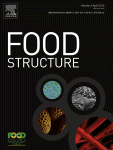
Food Structure-Netherlands
Charting New Territories in Food BiotechnologyFood Structure-Netherlands, published by Elsevier, stands at the forefront of research in the fields of Applied Microbiology and Biotechnology, Bioengineering, and Food Science. With its ISSN 2213-3291 and a commendable position in the 2023 Q1 category rankings, this journal serves as a vital platform for scholars and professionals seeking to explore the innovative intersections of food structure and its multifaceted applications. The journal has garnered significant recognition, ranking 67th in Food Science and 36th in Applied Microbiology and Biotechnology, placing it in the top echelons of its field with 82nd and 72nd percentiles, respectively. Spanning years from 2014 to 2024, Food Structure-Netherlands aims to disseminate high-quality research that fosters the advancement of knowledge, promoting sustainable practices and technological innovations in the food industry. Researchers, professionals, and students will find this journal to be an invaluable resource for cutting-edge studies and emerging trends in food structure and functionality.